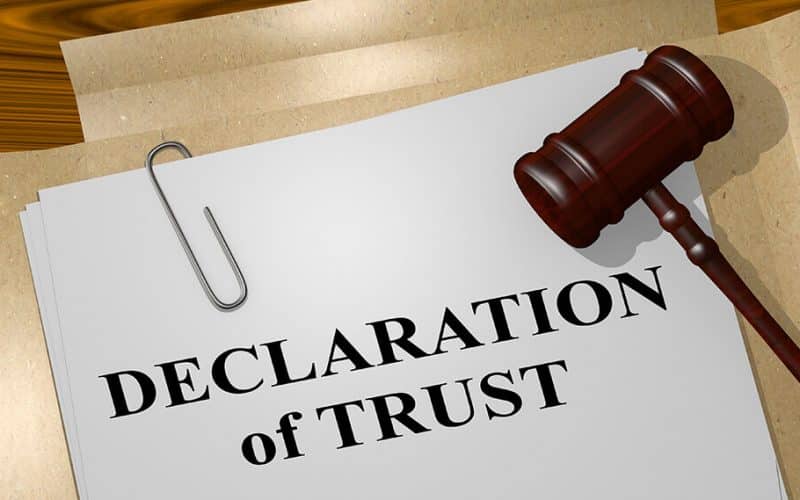If you need to explain how a property is held but are unable or unwilling to record the true status at the Land Registry, a declaration of trust might be the solution. So here is how to go about the declaration of trusts and how the revocation works in California and the other US states.
What is a Declaration of Trust?
A declaration of trust is a legal document for creating a new trust or to confirming the terms of an existing trust.
The declaration of trust acts as the legal contract between the trustee and the beneficiary. A named beneficiary is an individual – named in a legal document. It permits the individual to collect assets from IRAs, insurance policies, pension plans, and the administration of the trustee’s assets. As a legal document, the declaration of trust outlines the beneficiaries, trustees, and terms of the trust agreement. It can also be used to confirm the terms of a previously established trust.
Trustees and Beneficiaries
Before delving into the declaration of trust, it’s important to understand the legal relationship between beneficiaries and trustees. In a declaration of trust, the trustee administers assets. Total Assets refer to the sum of the book values of all assets owned by an individual, company, or organization. They keep it on behalf of the beneficiary. Although trustees are responsible for the administration of assets, the underlying assets still belong to the beneficiary.
A trustee is an individual or company that can hold and administer assets on behalf of a beneficiary. The individual follows the terms of the trust agreement. Banks, trust companies, and individuals are common trustees. In contrast, the beneficiary is the owner of the assets. He? She benefits from increases in the value of the underlying assets.
Under a trust agreement, you can administer many forms of assets, such as cash, securities, or real estate. Real Estate is real property that consists of land and improvements, which include buildings, fixtures, roads, structures, and utility systems. Property rights confer ownership of land, improvements, and natural resources such as minerals, plants, animals, water, and so on.
Read Also: IDGT Explained!!! (Understanding Intentionally Defective Grantor Trust)
Benefits of Putting Assets in Trust
Many advantages will force a beneficiary to manage their assets through a trust. We can use trusts in all aspects of financial planning. It ranges from retirement to taxes, due to the flexibility of trust agreements.
One of the advantages of trust is that one can manage the assets professionally assets. Also, it is used following the beneficiary’s original intent. A declaration of trust, for example, can ensure that funds are only used for specific purposes. The purposes range from education or charitable donations.
One can also use trusts to reduce income taxes and protect assets from creditors. Also, it ensures that they share the assets with multiple generations of beneficiaries. You can use the declaration of trust to establish trusts for a wide range of financial obligations. This is due to the flexibility of trust agreements.
Trust Declaration (England & Wales)
In England and Wales, a declaration of trust is a legal agreement that establishes the true owner of a property.
The declaration of trust is used by the beneficiary to transfer property to a trustee. The trustee’s name doesn’t have to appear on the deed. As a result, because the entry in the land registry may only include the name of the trustee. One can also use the declaration of trust to confirm the true owner of a property.
Kayla, for example, is purchasing an apartment in London with the assistance of her parents. Assume her parents are willing to provide her with 40% of the purchase price in exchange for 40% of any profits generated by the property.
By signing a declaration of trust, only Kayla’s name will appear on the deed. However, her parents will remain legal beneficiaries. If Kayla decides to sell her apartment for a profit, she must return 40% of the proceeds to her parents.
Read Also: SUCCESSOR TRUSTEE
Declaration of Trusts in California
Trusts, in general, are a highly versatile and adaptable estate-planning tool. Forming a trust in California can accomplish much of what the last will in California does such as distributing assets to heirs, without the need for a California probate. Furthermore, some irrevocable trusts can help reduce estate taxes, ensure medical eligibility, or keep assets in the family for multiple generations.
In California, a settlor can form a trust for almost any reason, as long as it is not illegal and is not in violation of the state’s public policy. For these reasons, declaration of a trust in California is a top priority for many people that have an interest in California estate planning.
How Declaration of Trusts in California works
Division 9 of the California Probate Code and generally applicable common law principles govern Trusts in California. All trusts share a basic structure and many key characteristics. A “settlor” (or “grantor”), one or more beneficiaries, and a trustee are all required parties in every trust. The settlor is the person who creates the trust and transfers the property to the trust. A beneficiary is someone who benefits from the assets held in trust, whether from the assets themselves or from the income generated by those assets. The duties of the trustee include managing the trust, which includes preserving and maintaining trust assets. The trustee also makes distributions to beneficiaries and acts on the trust’s behalf in legal matters.
Instructions in a declaration of trust in California can be broad, very specific, and explicit. Trustees are legally required to honor instructions provided in a trust instrument under California declaration of trust law (as are trustees in most other jurisdictions). Thus, trustees must make a good faith effort to manage the trust following its stated purpose.
Concerning the trust, a trustee has a “fiduciary relationship” with the beneficiaries. That is, while the trustee has the legal authority to exercise control over trust assets, he or she must always act in the best interests of the beneficiaries. A trustee must ensure that there is proper maintenance of the trusts’ assets. A trustee tasked with investing must do so prudently. Courts will not usually second-guess a trustee who makes a good-faith investment that happens to lose money. However, trustees can be held liable for trust losses caused by the trustee’s neglect, or other breaches of the fiduciary duty.
Revocation of Trust Declaration
The basic steps in revoking a revocable trust are straightforward. They include the transfer of assets and the filing of an official document of dissolution.
A revocable trust is a legal entity/financial structure that allows the person who creates it, known as the grantor, to change, remove, or alter the trust assets—or, indeed, amend the trust itself or its beneficiaries—at any time during his or her lifetime. A revocable trust, also known as a living trust, is frequently used to transfer assets to heirs while avoiding the time and expenses associated with probate—which they would often incur if assets were simply bequeathed to them in a will. The trust’s income is distributed to the grantor during its life, and its property is transferred to the beneficiaries only after death.
IMPORTANT TAKEAWAYS
As the name implies, one can alter or completely revoke the revocable trusts at any time by their grantor.
- The first step in dissolving a revocable trust is to remove all assets transferred into it.
- The next step is to complete a formal revocation form, which expresses the grantor’s desire to dissolve the trust.
- The grantor must sign the official revocation declaration and have it notarized. In some cases, you fill it with local probate or estate court.
Reasons for Revocation of Declaration of Trust
People may withdraw their trust for a variety of reasons. Usually, it entails a significant change in one’s life. A divorce, for example, is one of the most common reasons for revoking a trust if it was as a joint document with one’s soon-to-be ex-spouse.
A trust may also be revoked if the grantor wishes to make changes that are so significant. It would be easier to dissolve the trust and create a new one than to try to make significant changes. A revocable trust can also be revoked if the grantor wishes to appoint a new trustee or change the trust’s provisions entirely.
Since they bypass probate, you cannot exclude revocable trusts from estate taxes unless the grantor maintains ownership of them throughout his or her lifetime. The properties are part of the taxable estate because the grantor retains control of them during his or her lifetime.
How Revocation from a Trust Declaration Works
- The first step in the revocation of declaration trust is to delete all assets moved into it. This practice entails modifying names, deeds, or other legal documents to shift ownership from the trust asset back to the grantor of the trust.
- The second step in revoking the trust is to produce a legal document stating that the trust’s owner, who has the authority to revoke the trust, wants to revoke all terms and conditions of the trust and dissolve it fully. Such papers, known as a “trust revocation declaration” or “revocation of a living trust,” can be downloaded from legal websites. Also, you can obtain copies from local probate courts.
However, it is also best to have an estate lawyer draft one for you, or at least check the one you have. This is to ensure that the wordings are correct and meet all of the requirements of your state’s laws. Also, if the trust has a lot of properties, it is often better to let a competent solicitor ensure that anything has been properly transferred out of it.
If the trust being dissolved was registered with a specific court, the dissolution paperwork should be lodged with that court; otherwise, bind it to the trust papers and store it with your will or new trust documents.
How can a Declaration of Trust be dissolved or terminated?
A Declaration of Trust can be dissolved or terminated by mutual agreement between the trustees, by a change in circumstances, such as the sale of the property, or by a court order. The specific process for dissolving or terminating the Declaration of Trust will depend on the terms of the agreement and the laws of the jurisdiction where the property is located.
How is a Declaration of Trust enforced after the death of the trustees?
If the Declaration of Trust includes provisions for the appointment of new trustees in the event of the death of one or more of the existing trustees, the trust can continue to be enforced. If there are no provisions for the appointment of new trustees, the trust will typically be dissolved and the property will be distributed according to the terms of the trust or the laws of the jurisdiction where the property is located.
What happens if the terms of the Declaration of Trust are breached?
If one or more of the trustees breaches the terms of the Declaration of Trust, the other trustees or the beneficiaries may take legal action to enforce the terms of the agreement. This could include seeking a court order to require the breaching trustee to comply with the terms of the trust, or seeking damages for any losses incurred as a result of the breach.
Can a Declaration of Trust be challenged in court?
Of course, it can be well challenged in court if one of the trustees or beneficiaries believes that the terms of the agreement have been violated or that the trust has been mismanaged. The specific grounds for challenging a Declaration of Trust will depend on the terms of the agreement and the laws of the jurisdiction where the property is located.
What are the advantages and disadvantages of using a Declaration of Trust?
The advantages of using a Declaration of Trust include providing a clear understanding of the ownership and management of property, protecting the interests of all parties involved, and avoiding disputes over ownership and control. The disadvantages can include the cost of creating and maintaining the trust, and the potential for disputes between the trustees or beneficiaries.
Can a Declaration of Trust be used in conjunction with a living trust?
Yes, a Declaration of Trust can be used in conjunction with a living trust. In this scenario, the Declaration of Trust would typically be used to specify the terms of ownership and management of the property, while the living trust would be used to manage the distribution of the property after the death of the trustees.
How is a Declaration of Trust different from joint ownership of property?
The Declaration of Trust is a specific agreement between two or more parties regarding the ownership and management of property, while joint ownership of property refers to a situation in which two or more people own the property together. A Declaration of Trust can be used to specify the terms of joint ownership, such as how the property will be managed, how profits will be distributed, and what will happen if one of the owners dies.
Can a Declaration of Trust be used in estate planning?
Yes, it can be used as a tool in estate planning. For example, a Declaration of Trust can be used to specify how property will be managed and distributed after the death of one or more of the trustees, or to protect the interests of beneficiaries who may be minors or otherwise unable to manage the property on their own.
Conclusion
Trusts are a versatile financial planning tool that can serve a variety of purposes. They are, however, often complex and sophisticated. A skilled California estate planning attorney can assist you in evaluating your current financial situation, developing a strategy for achieving your objectives, and determining whether one or more trusts are appropriate for the goals you want to achieve.
Declaration of Trust FAQs
Is a Declaration of Trust necessary?
Without a Declaration of Trust, each of you is legally entitled to 50% of the equity in the property – regardless of how much each of you has contributed to the initial deposit and mortgage payments
What is the difference between a Trust and a Declaration of Trust?
If you are the sole Trustee of the Trust, the document used to create it is called a “declaration of trust.” If there is an additional Trustee, the document used to create the trust is called a “trust agreement.
Who holds the declaration of trust?
A declaration of trust is an important document in which ‘trustees’ are appointed to hold the property for ‘beneficiaries’. It appoints people as trustees who are ‘trusted’ to act in an appropriate manner and always in the interests of the beneficiaries and is governed by The Trustee Act 2000.
Does a will override a declaration of trust?Does a Declaration of Trust override a Will?
A Declaration of Trust does not override a Will. The Declaration of Trust will set out your interest in the property but the Will will set out what will happen to your interest in the property after you have passed away







